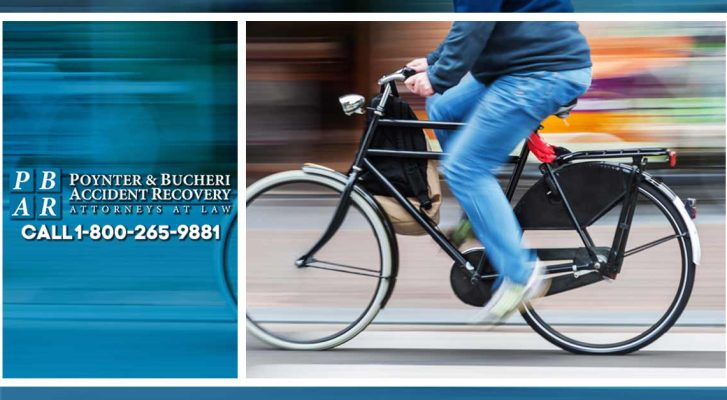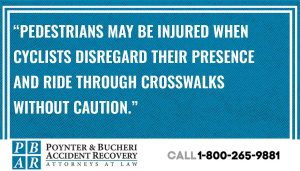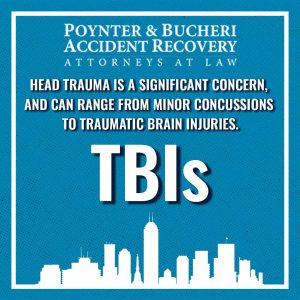
What Happens If a Bike Hits You In Indiana?

Unfortunately, bicycle accidents are becoming more common in Indiana. When a bike collides with a pedestrian, there can be severe consequences, including injuries, medical expenses, property damage, and sometimes death.
Poynter & Bucheri created this article to explain your legal options if the driver of a bicycle hits you in Indiana. It explores the legal landscape, your rights as a cyclist, and what steps to take if you find yourself in such a situation.
Contact our firm here or call 1-800-265-9881 for a free case consultation with a bicycle accident lawyer after any bicycle or car accident in Indiana.
Steps to Take at the Accident Scene After a Bike Accident
If you’re involved in a bicycle accident in Indiana, it’s essential to take the following steps to protect your well-being and legal rights:
- Seek medical attention: Your health and safety should be the top priority when a bicycle hits you. Even if you don’t feel seriously injured, seek medical care so they can assess you for hidden injuries.
- Document the scene where the accident happened: Gather evidence at the accident scene, including photos of each car or bike involved, your injuries, and any road conditions that may have contributed to the accident. Make note of any cameras in the area. (Later, your bicycle accident lawyer can access security or traffic camera footage and communicate with witnesses.)
- Exchange information: Obtain the contact and insurance information of the driver involved in the bicycle accident and any witnesses present at the scene.
- File a police report about the bicycle accident: Contact a police officer so they can create a police report about the accident. An official police bicycle accident report can be valuable evidence in your personal injury claim.
- Consult with a bicycle accident lawyer: Seek legal guidance from an experienced personal injury attorney specializing in compensation following an accident. They will assess your bicycle accident case, protect your rights, and file a claim to advocate for the compensation you deserve.
What Are The Most Common Causes Of Bicycles Hitting Pedestrians?
Some common causes of pedestrians being hit by cars or cyclists and suffering harm include:

Failing to yield to pedestrians: Pedestrians may be injured when cyclists disregard their presence and ride through crosswalks without caution.
Weaving through pedestrian traffic: Pedestrians or even a car may be struck when cyclists aggressively navigate through crowds without warning.
Distracted cycling: Checking phones, eating, or other distracted driving habits while cycling can cause accidents where a bicycle hits a pedestrian.
Failing to observe while turning: Cyclists must be vigilant when turning and crossing into areas with limited visibility. Failure to observe pedestrians and making an improper turn can lead to accidents and serious injuries as cyclists proceed without acknowledging pedestrians’ presence.’
Speeding or reckless cycling: Cyclists who travel at excessive speeds or engage in reckless behavior, such as weaving in and out of pedestrian traffic or failing to keep a safe distance, pose a significant risk to pedestrians.
Failure to use proper signaling: Cyclists are responsible for signaling their intentions, such as turning or stopping, to other road users, including pedestrians and drivers of motor vehicles. Failure to use appropriate hand signals can lead to confusion and accidents.
Poor visibility: Cyclists should ensure they are visible to pedestrians, especially in low-light conditions or areas with limited visibility. Lack of visibility, whether due to inadequate lighting, obscured visibility from obstacles, or wearing dark clothing, increases the likelihood of collisions with pedestrians.
Riding while ignoring road rules, traffic signals, and signs: A driver of a bicycle who disregards a red light, lane marking, or traffic sign puts pedestrians at risk when crossing intersections or designated pedestrian crossings.
Inadequate maintenance of bicycles: Poorly maintained bicycles, including those with faulty brakes or worn-out tires, can contribute to accidents. Cyclists should regularly inspect and maintain their bicycles to ensure they are safe and working correctly.
Getting used to riding a new bike: A cyclist riding in public before getting thoroughly familiar with controls, functions, and limitations can lead to accidents. Inexperience of the involved party can cause a slower response time to surroundings, increasing the likelihood of collisions with pedestrians or causing crashes leading to serious consequences.
Did the Bicycle That Hit Me Have the Right-of-Way?
Bicyclists must abide by the same rules as other vehicles. No rule grants bicyclists the right-of-way in traffic. If the bicyclist who caused your accident did not have the right-of-way, you may have grounds for a personal injury claim.
In Indiana, cyclists must yield to pedestrians on multi-use paths, bicycle lanes, and roads. When approaching pedestrians from behind, they must audibly signal their intent and pass with sufficient space to ensure safety. If these rules weren’t followed and a pedestrian was injured as a result, it’s negligence that strengthens personal injury cases and the ability to recover damages.
Proving negligence on the part of the bicycle rider increases the chance you’ll recover compensation.
Understanding Indiana Bicycle Laws
Before exploring the aftermath of a bike accident, it’s crucial to understand Indiana’s bicycle laws. These traffic laws protect pedestrians and ensure their safety on the road.
Some key points to note include:
Right of Way: The law requires cyclists to have the same rights, rules, and responsibilities as motorists. They are entitled to the same right of way as other vehicles on the road.
Designated Bike Lane Usage: Cyclists are encouraged to use designated bike lanes when available but are not obligated to do so. They can ride on the road where bike lanes are absent.
Passing Distance: Motorists must provide at least three feet of clearance when passing a vehicle or a cyclist. A third vehicle or cyclist riding dangerously close to cars violates traffic laws and may cause an accident.
Traffic Signals: Cyclists must obey all traffic lights and signs like motorists.
Determining Fault in an Indiana Bicycle Accident Lawsuits
Most personal injury claims pedestrians make against cyclists after a bicycle-pedestrian accident are negligence claims.
To prove a claim of negligence in Indiana, a pedestrian must show that:
The cyclist owed the pedestrian a duty of care: All cyclists must exercise reasonable care to avoid harming pedestrians on the road or sidewalks.
The cyclist breached their duty of care: To prove that a cyclist breached their duty of care, the pedestrian must show that the cyclist failed to exercise reasonable care. One way to do this is to demonstrate that the cyclist acted recklessly or violated traffic laws.
The pedestrian must prove fault and be harmed due to the cyclist’s breach: It’s not sufficient that the cyclist failed to exercise reasonable care; the pedestrian must prove that this specific failure directly caused the accident and resulting harm.
Who Might Be Legally Responsible For My Accident?
Initially, it may seem that the driver of a car or cyclist is solely responsible for the accident they were involved in, but that’s not always true.
Other responsible or involved parties may include:
Motorists: Just as each car driver owes others on the road a duty to exercise reasonable care, cyclists have the same duty. If a cyclist breaches this duty of care and injures a pedestrian, the cyclist will be charged with negligence.
Towns or cities: Premises liability laws mandate property owners must keep their property safe. If a pedestrian suffers an injury or wrongful death due to unsafe conditions on public property, police or the owner (often the town or city) can be held at fault.
Manufacturers: The manufacturer may be liable if a defective product, such as a faulty bicycle component, causes a bicycle accident. These instances especially require the services of an attorney as the large insurance companies of the other party will fight hard to avoid paying.
Common Types of Bicycle Injuries
Pedestrians struck by bicycles can suffer a range of injuries, depending on factors like the bike’s speed, the angle of impact, and the physical condition of the person involved. The severity of injuries can vary from minor cuts and bruises to severe injuries like head trauma, spinal injuries, or death.
Here are some common types of injuries people may suffer when hit by a bicycle:
1. Soft Tissue Injuries: These include bruises, cuts, scrapes, and abrasions, which can be minor but can still cause pain and discomfort.
2. Fractures: The impact of a bicycle collision can result in broken bones, such as fractures in the arms, legs, hands, or ribs. Fractures can vary in severity, from hairline fractures to complete breaks.

3. Head Trauma: Head trauma is a significant concern and can range from minor concussions to traumatic brain injuries (TBIs). These injuries may lead to wrongful death.
4. Facial Damage: The face is particularly vulnerable during a bicycle collision. Injuries may include cuts, bruises, fractures of the nose or cheekbones, dental issues, or even eye damage.
5. Spinal Cord Injuries: Severe impacts can lead to spinal cord injuries, which may result in paralysis or other neurological deficits. These injuries can have life-altering consequences and require immediate medical attention.
6. Internal Injuries: The force of a collision can cause internal injuries, such as organ damage or internal bleeding. These injuries may not be immediately apparent and require medical evaluation.
7. Musculoskeletal Damage: Ligament sprains, tendon tears, and muscle strains can occur due to sudden impact or twisting motion during a collision. Symptoms typically include pain and limited mobility.
8. Emotional Trauma: In addition to physical injuries, being hit can also cause emotional trauma, such as anxiety, post-traumatic stress disorder (PTSD), or depression, especially if the accident was severe or resulted in the loss of a loved one.
It’s essential to seek medical care promptly after being hit because some injuries may not be immediately apparent.
Additionally, documenting injuries and seeking legal advice on your legal options can be crucial steps in seeking compensation, recovering damages, and addressing the consequences of the accident.
Remember not to offer a recorded statement to the driver of the other car or vehicle or their insurance company. You never want to admit fault for your accident because it might haunt you later.
Your medical records and property damage receipts help prove you have a personal injury case from being hit by a negligent bicyclist.
Damages You May Receive From Insurance After a Cyclist Hits You
In Indiana, a pedestrian with a bike-related injury can seek both economic and non-economic damages from negligent parties.
Economic damages: Economic damages represent the monetary financial losses caused by an accident, like medical expenses, lost income, and property damage.
Noneconomic damages: Noneconomic damages are the non-monetary losses you’ve suffered because of an accident that was not your fault, including pain, suffering, and emotional distress.
If the at-fault party intentionally or maliciously hit you, you may also be able to sue for punitive damages.
Poynter & Bucheri- Indianapolis Personal Injury Lawyers
Poynter & Bucheri legal team of personal injury attorneys are here to help if you’ve been hurt in a pedestrian-cyclist accident. We’ll work tirelessly to build your case, contact witnesses, communicate with the insurance company, prove negligence against the driver of the car or other vehicle that hit you, and pursue the compensation you deserve from the other party for vehicle damages, medical bills, lost wages, pain and suffering, and more.
First, call the police. Second, call Poynter & Bucheri Accident Recovery.
When you were injured by the driver or a bicycle, car, or other vehicle that hit you, you deserve the full compensation available from your insurance and the insurance of the person or entity who was at fault for your accident.
Contact us today for a free consultation about your claim at 1-800-265-9881 or schedule a free case review online. Let us advocate for your rights and help you achieve the justice you deserve.
